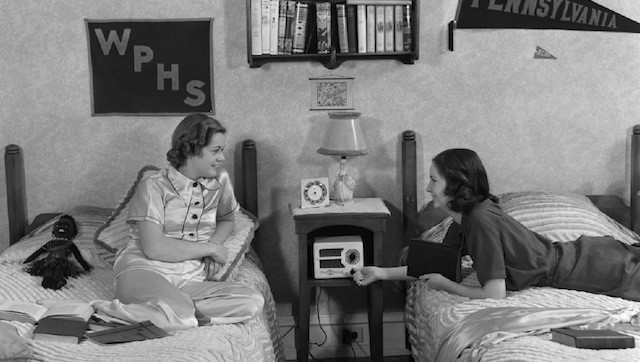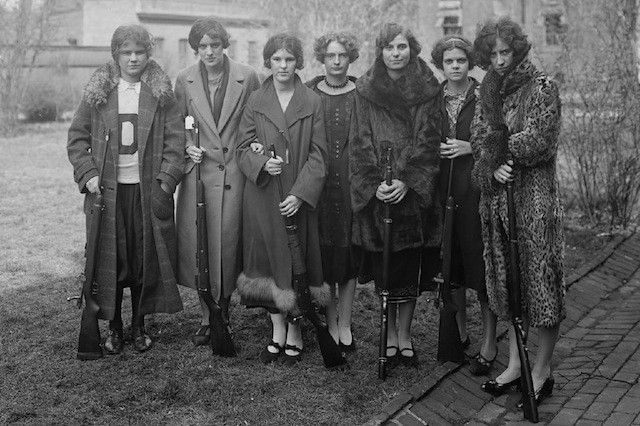“The Teenager Was the Invention of Adolescent Girls”: An Interview With Matt Wolf
by Dina Gachman

Teenagers didn’t always exist. That’s one of the first things you’re told in Matt Wolf’s new documentary Teenage, a hypnotic meditation on the rise of youth culture from the end of the 19th century to the first half of the 20th century. The film was written by Jon Savage and based on his book Teenage: The Creation of Youth Culture 1875–1945, and it’s full of incredible found footage, old photos, and unearthed home movies made by German Swing Kids. This isn’t a dull, academic dissection of youth — it’s part poetry, part punk manifesto about the birth of youth culture.
Today we have convenient labels like Millennials, Gen Y, and Gen X. Back then it was Flappers, Sub-Debs, Jitterbugs, Hitler Youth, and German Wandervogel, a sort of 60s hippie prototype made up of kids who wanted to return to nature after the trauma of World War I.
Wolf got Bradford Cox (Deerhunter/Atlas Sound) to score the film and Jena Malone, Ben Whishaw, Julia Hummer and Jessie Usher read from a mix of old diary entries and written testimony from teens he and Savage found in newspapers and books. One of the most intriguing figures is Brenda Dean Paul, a 1920s British actress and socialite who was a member of the Bright Young Things — a nickname the tabloids gave to wealthy kids (including Cecil Beaton and Evelyn Waugh) who ran around London getting famous for looking fabulous, doing drugs, and throwing elaborate, themed parties, like a “Bath and Bottle Party” at a swimming pool. The invitation told people to “bring a bath towel and a bottle.” Sort of like the less offensive ancestor of “bros and hoes” parties. Sadly, Brenda Dean Paul eventually got hooked on morphine, wrote an autobiography called My First Life, became fodder for the gossip rags, and faded into history.
I talked to Wolf about what inspired him to make the film, his favorite discovery along the way, and how “the teenager was the result and invention of adolescent girls.”
You were inspired to make the film when you read Jon Savage’s book, but was it hard to convince him to let you do it?
It wasn’t so hard to convince him — I think it was harder to convince myself that it would be possible to adapt his book. It covered so much material that it was intimidating. I read his book and was struck by how different his style of storytelling was; it wasn’t academic. He wrote a famous book about punk called England’s Dreaming and I felt like his punk perspective really colored his depiction of history.
How did you pitch your idea for the film?
I went to him proposing to make a different kind of historical film, one that breaks from the conventions of Ken Burns and PBS — something that embraced that punk spirit.
Most of the voiceover is from actual old diary entries, but did you guys write any original material? I just ask because some of the footage — like the footage of Brenda Dean Paul — is made up of reenactments.
There is some scripted material to provide some historical context, but in general we rendered the voice of youth from actual quotes and teenage diaries and written testimony in newspapers and books.
The found footage is so amazing and well preserved that it’s kind of eerie. Did any of the footage really startle you as you were researching?
There were a couple of things in the footage that blew my mind. For one thing the color home movies of German Swing Kids just felt like such a secret that had been discovered. Those people were risking their lives to smuggle in fashion from other countries, and the fact that they filmed each other and that it has been preserved was astounding to me. The home movies we found of young people dressing up in drag in the 1920s — those kinds of things felt so hideously rare to me that it was so exciting to find them.
Brenda Dean Paul is really interesting because she seems so contemporary in a way, like a Bling Ring kid or Paris Hilton — someone who got famous for flaunting material things and partying, basically.
Totally, or Lindsay Lohan. I discovered her in the book and she’s a sort of an obscure figure. I was really intrigued by her contemporary archetype — she was elevated by the media as this kind of aspirational figure but at the same time publicly crucified and condemned, and she had this public downfall. It’s something you see a lot in pop culture now with Lindsay Lohan or Justin Bieber. There is a kind of sexist quality to it as well, a crucifixion of the young female figure, and that’s something that as a culture we do a lot.

In the film you make the point that teen girls were a really galvanizing force as far as youth movements and youth culture.
The teenager was the result and invention of adolescent girls. They were the ones buying the magazines, the cosmetics, the clothes, and the records that were changing people’s attitudes. Once they started expressing themselves with their own pop culture there was an opportunity for marketing and it was through that input that they got recognized as a distinct class.
How did you direct the actors who do the voiceover? Did you give them anything specific?
I didn’t want them to mimic the style of dialogue from different periods; I wanted them to speak in a contemporary way. The goal was to try to evoke a more universal, emotional experience of youth. My main direction was dreaminess. It was meant to be in the headspace of a teenager and I think that headspace is a very dreamy space.
How did the score come about? It’s definitely dreamy.
I just love Bradford Cox’s aesthetic and his creative point of view, and he watched a rough cut and was inspired by what he saw and he created this body of music. It was like a joining of aesthetics.
What were you like as a teenager? What group from the film would you want to be a part of?
I was a super political teenager and I was involved in a lot of gay activism when I was younger. I was also into alternative and underground music and film so there were two sides to my personality when I was young. When I started making this film I thought it would be a deeper exploration of pop culture but I found that it was actually really political and it made sense to me because I was so politically active as a young person. If there were a group that I would want to be a part of it would be the jitterbugs because they were the coolest.
Did making this film and immersing yourself in all this teen history change your view of teenagers today at all?
I definitely have a more idealized view of youth today. I think when we get older no matter how progressive or forward-thinking we think we are there’s such an impulse to see young people as apathetic or conformist or commercialized, and to think that our generation has more authenticity or integrity. I think that’s a destructive impulse and that’s what really leads us to the generation gap. Young people are doing really interesting things that have a political dimension but it’s really hard to identify those things as they’re happening in real time.
Like putting down Millennials and saying they’re lazy and entitled.
Yes. All my friends do it. People resist forging friendships with younger people because they don’t try to identify with them. Now I try more to identify with them.
Can you talk about your Hilary Knight project?
I’m collaborating with Lena Dunham and Jenni Konner from Girls and it’s a profile Hilary Knight who created Eloise, and it’s about his complicated and long history with the character and with his original collaborator, Kay Thompson. It’ll be on HBO, and we’re in the process of editing it right now.
Oscilloscope releases Teenage March 14.
Previously: An Interview with Kathleen Hanna
Dina Gachman is a writer in Los Angeles. Look out for her first book, Brokenomics, coming from Seal Press in spring 2015. She’s on Twitter @TheElf26.